Investigating Students’ Sustainability Awareness and the Curriculum of Technology Education in Pakistan
Abstract
1. Introduction
- To what extent does sustainability awareness exist among students?
- How much sustainability is infused across the technology education curriculum?
2. Literature Review
2.1. Sustainability in the Context of Technology Education
2.2. Education for Understanding Sustainability
2.3. Significance of Sustainability Awareness
3. Research Methodology
3.1. Document Analysis
3.1.1. Create a List of Text to Explore
3.1.2. How the Text is Assessed
3.1.3. Acknowledge and Addressing Bias
3.1.4. Skills for Research
3.1.5. Data Relevance
3.2. Conduction of Survey
3.2.1. Data Sources
3.2.2. Data Analysis
4. Results
4.1. Results from Document Analysis
4.2. Survey Results
5. Analysis
6. Discussion
7. Conclusions
Author Contributions
Acknowledgments
Conflicts of Interest
Appendix A
| Sr. # | Questions | Sample Size of Survey Questionnaire: 144 | |||||||
|---|---|---|---|---|---|---|---|---|---|
| Optimistic | Pessimistic | Impartial | |||||||
| EA | MA | Optimistic % | SA | NAA | Pessimistic % | SWA | % | ||
| 1 | Are you familiar with the concept of environmental sustainability? | 24 | 27 | 35.42 | 38 | 26 | 44.44 | 28 | 19.44 |
| 2 | The environment-friendly technology can contribute to a healthy environment. | 18 | 37 | 38.19 | 41 | 19 | 43.06 | 26 | 18.06 |
| 3 | Energy efficient technology is the contributors towards sustainable environment. | 15 | 24 | 27.08 | 38 | 28 | 45.83 | 39 | 27.08 |
| 4 | Technology can emit heat in environment. | 14 | 23 | 25.69 | 42 | 41 | 57.64 | 24 | 16.67 |
| 5 | Technology can be the main driver that can have social influence. | 19 | 21 | 27.78 | 33 | 37 | 48.61 | 34 | 23.61 |
| 6 | Technology can provides automation to various business sectors to contribute to society. | 35 | 38 | 50.69 | 32 | 20 | 36.11 | 19 | 13.19 |
| 7 | Technology can aid to live a better and healthy life. | 18 | 28 | 31.94 | 28 | 34 | 43.06 | 36 | 25.00 |
| 8 | Technology contributes to society by providing information and learning. | 26 | 38 | 44.44 | 37 | 17 | 37.50 | 26 | 18.06 |
| 9 | Technology can produces economical solutions in industry. | 21 | 32 | 36.81 | 37 | 23 | 41.67 | 31 | 21.53 |
| 10 | Technology can help to increase productivity of organizations. | 26 | 38 | 44.44 | 33 | 19 | 36.11 | 28 | 19.44 |
| 11 | Technology can contribute for economical sustainability. | 21 | 31 | 36.11 | 35 | 29 | 44.44 | 28 | 19.44 |
| 12 | Technology to be sustained over a long period of time is the success of the software. | 31 | 38 | 47.92 | 31 | 17 | 33.33 | 27 | 18.75 |
| 13 | Technology can be sustained by integrating sustainability aspects in software engineering? | 18 | 24 | 29.17 | 36 | 35 | 49.31 | 31 | 21.53 |
| 14 | Sustainable Technology addresses sustainability practices including code optimization, resources utilization and energy efficient coding. | 22 | 23 | 31.25 | 38 | 29 | 46.53 | 32 | 22.22 |
References
- Muhammad Salam, S.U.K. Challenges in the development of green and sustainablesoftware for software multisourcing vendors: Findings from asystematic literature review and industrial survey. J. Softw. Evol. Process 2018, 30, e1939. [Google Scholar] [CrossRef]
- Aleixo, A.M.; Leal, S.; Azeiteiro, U.M. Conceptualization of sustainable higher education institutions, roles, barriers, and challenges for sustainability: An exploratory study in Portugal. J. Clean. Prod. 2018, 172, 1664–1673. [Google Scholar] [CrossRef]
- Laurischkat, K.; Jandt, D. Techno-economic analysis of sustainable mobility and energy solutions consisting of electric vehicles, photovoltaic systems and battery storages. J. Clean. Prod. 2018, 179, 642–661. [Google Scholar] [CrossRef]
- Saunila, M.; Ukko, J.; Rantala, T. Sustainability as a driver of green innovation investment and exploitation. J. Clean. Prod. 2018, 179, 631–641. [Google Scholar] [CrossRef]
- Calero, C.; Piattini, M. Introduction to Green in Software Engineering. In Green in Software Engineering; Calero, C., Piattini, M., Eds.; Springer International Publishing: Cham, Switzerland, 2015; pp. 3–27. [Google Scholar] [CrossRef]
- Nations, U. World Commission on Environment and Development: Our Common Future; Oxford University Press: Oxford, UK, 1987. [Google Scholar]
- Lago, P. Challenges and opportunities for sustainable software. In Proceedings of the Fifth International Workshop on Product LinE Approaches in Software Engineering, Florence, Italy, 16–24 May 2015; pp. 1–2. [Google Scholar]
- Dick, M.; Drangmeister, J.; Kern, E.; Naumann, S. Green software engineering with agile methods. In Proceedings of the 2013 2nd International Workshop on Green and Sustainable Software (GREENS), San Francisco, CA, USA, 20 May 2013; pp. 78–85. [Google Scholar]
- Marimuthu, C.; Chandrasekaran, K. Software Engineering Aspects of Green and Sustainable Software: A Systematic Mapping Study. In Proceedings of the 10th Innovations in Software Engineering Conference, Jaipur, India, 5–7 February 2017; pp. 34–44. [Google Scholar]
- Taina, J.; Mäkinen, S. Green Software Quality Factors. In Green in Software Engineering; Calero, C., Piattini, M., Eds.; Springer International Publishing: Cham, Switzerland, 2015; pp. 129–154. [Google Scholar] [CrossRef]
- Palacin-Silva, M.V.; Seffah, A.; Porras, J. Infusing sustainability into software engineering education: Lessons learned from capstone projects. J. Clean. Prod. 2018, 172, 4338–4347. [Google Scholar] [CrossRef]
- Penzenstadler, B. Towards a definition of sustainability in and for software engineering. In Proceedings of the 28th Annual ACM Symposium on Applied Computing, Coimbra, Portugal, 18–22 March 2013; pp. 1183–1185. [Google Scholar]
- Brown, B.J.; Hanson, M.E.; Liverman, D.M.; Merideth, R.W. Global sustainability: Toward definition. Environ. Manag. 1987, 11, 713–719. [Google Scholar] [CrossRef]
- Chofreh, A.G.; Goni, F.A.; Shaharoun, A.M.; Ismail, S.; Klemeš, J.J. Sustainable enterprise resource planning: Imperatives and research directions. J. Clean. Prod. 2014, 71, 139–147. [Google Scholar] [CrossRef]
- Chofreh, A.G.; Goni, F.A. Review of frameworks for sustainability implementation. Sustain. Dev. 2017, 25, 180–188. [Google Scholar] [CrossRef]
- Steigerwald, B.; Agrawal, A. Green Software. In Harnessing Green It; John Wiley & Sons, Ltd.: Hoboken, NJ, USA, 2012; pp. 39–62. [Google Scholar] [CrossRef]
- Penzenstadler, B.; Bauer, V.; Calero, C.; Franch, X. Sustainability in software engineering: A systematic literature review. In Proceedings of the 16th International Conference on Evaluation & Assessment in Software Engineering (EASE 2012), Ciudad Real, Spain, 14–15 May 2012; pp. 32–41. [Google Scholar]
- Penzenstadler, B.; Raturi, A.; Richardson, D.; Calero, C.; Femmer, H.; Franch, X. Systematic mapping study on software engineering for sustainability (SE4S). In Proceedings of the 18th International Conference on Evaluation and Assessment in Software Engineering, London, UK, 13–14 May 2014; pp. 1–14. [Google Scholar]
- Amsel, N.; Ibrahim, Z.; Malik, A.; Tomlinson, B. Toward sustainable software engineering (NIER track). In Proceedings of the 33rd International Conference on Software Engineering, Waikiki, HI, USA, 21–28 May 2011; pp. 976–979. [Google Scholar]
- Hugé, J.; Mac-Lean, C.; Vargas, L. Maturation of sustainability in engineering faculties—From emerging issue to strategy? J. Clean. Prod. 2018, 172, 4277–4285. [Google Scholar] [CrossRef]
- Malik, M.N.; Khan, H.H.; Subhan, F. Sustainable Design of Mobile Icons: Investigating Effect on Mentally Retarded User’s. J. Med. Imaging Health Inform. 2017, 7, 1419–1428. [Google Scholar] [CrossRef]
- Stough, T.; Ceulemans, K.; Lambrechts, W.; Cappuyns, V. Assessing sustainability in higher education curricula: A critical reflection on validity issues. J. Clean. Prod. 2018, 172, 4456–4466. [Google Scholar] [CrossRef]
- Perez-Foguet, A.; Lazzarini, B.; Giné, R.; Velo, E.; Boni, A.; Sierra, M.; Zolezzi, G.; Trimingham, R. Promoting sustainable human development in engineering: Assessment of online courses within continuing professional development strategies. J. Clean. Prod. 2018, 172, 4286–4302. [Google Scholar] [CrossRef]
- Tejedor, G.; Segalàs, J.; Rosas-Casals, M. Transdisciplinarity in higher education for sustainability: How discourses are approached in engineering education. J. Clean. Prod. 2018, 175, 29–37. [Google Scholar] [CrossRef]
- Bowen, G.A. Document Analysis as a Qualitative Research Method. Qual. Res. J. 2009, 9, 27–40. [Google Scholar] [CrossRef]
- O’Leary, Z. The Essential Guide to Doing Your Research Project; Sage: London, UK, 2017. [Google Scholar]
- Penzenstadler, B.; Betz, S.; Venters, C.C.; Chitchyan, R.; Porras, J.; Seyff, N.; Duboc, L.; Becker, C. Blueprint and Evaluation Instruments for a Course on Software Engineering for Sustainability. arXiv 2018, arXiv:1802.02517. [Google Scholar]
- Akins, E.E.; Giddens, E.; Glassmeyer, D.; Gruss, A.; Hedden, M.K.; Slinger-Friedman, V.; Weand, M. Sustainability Education and Organizational Change: A Critical Case Study of Barriers and Change Drivers at a Higher Education Institution. Sustainability 2019, 11, 501. [Google Scholar] [CrossRef]
- Calafell, G.; Banqué, N.; Viciana, S. Purchase and Use of New Technologies among Young People: Guidelines for Sustainable Consumption Education. Sustainability 2019, 11, 1541. [Google Scholar] [CrossRef]
- Boca, G.D.; Saraçlı, S. Environmental Education and Student’s Perception, for Sustainability. Sustainability 2019, 11, 1553. [Google Scholar] [CrossRef]
- Waltner, E.-M.; Rieß, W.; Mischo, C. Development and Validation of an Instrument for Measuring Student Sustainability Competencies. Sustainability 2019, 11, 1717. [Google Scholar] [CrossRef]
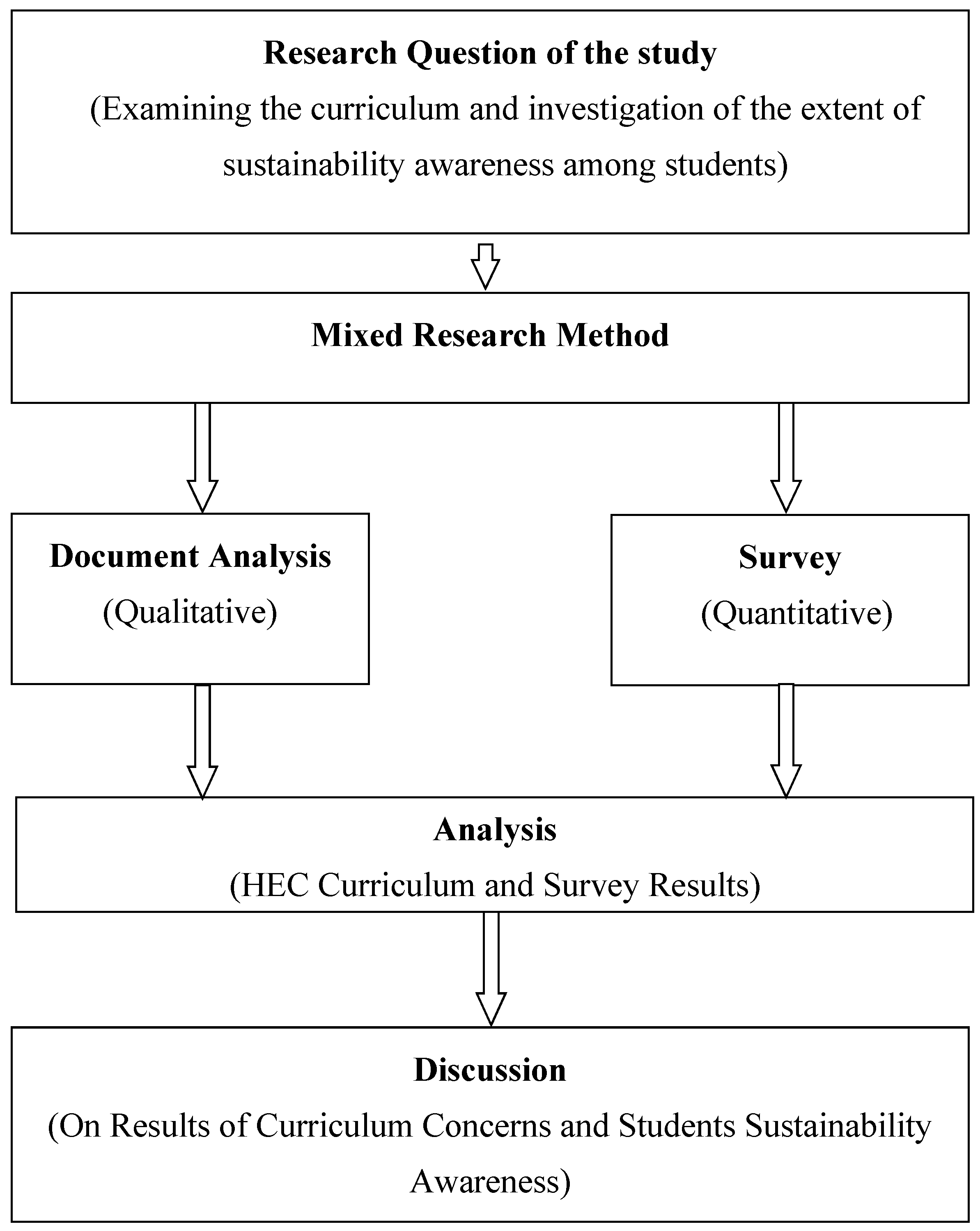
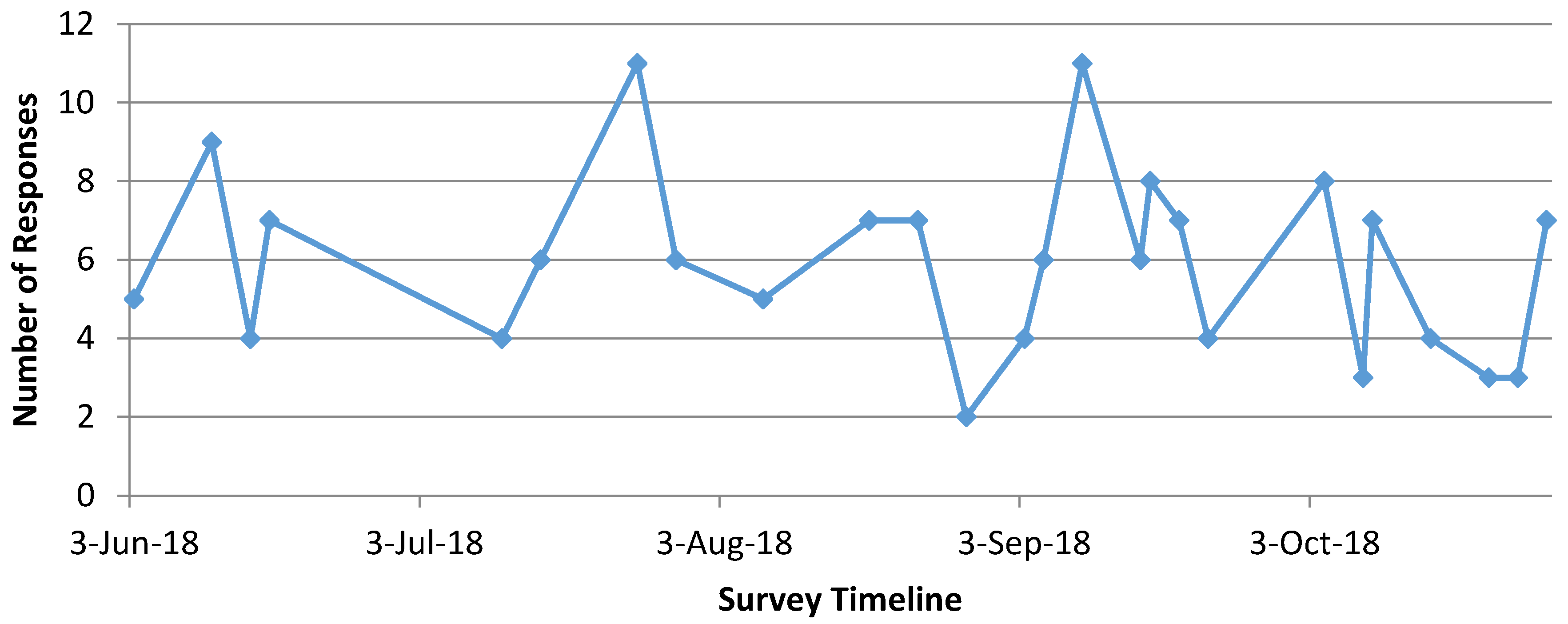
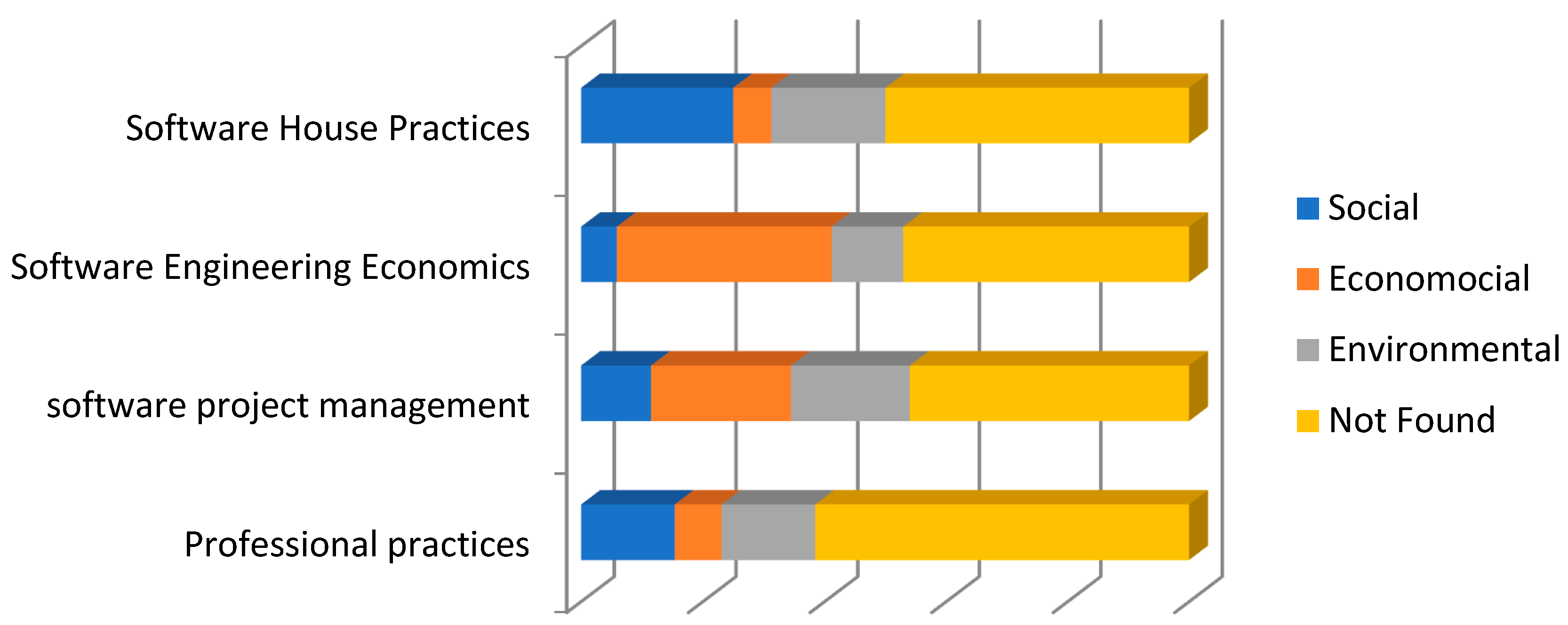
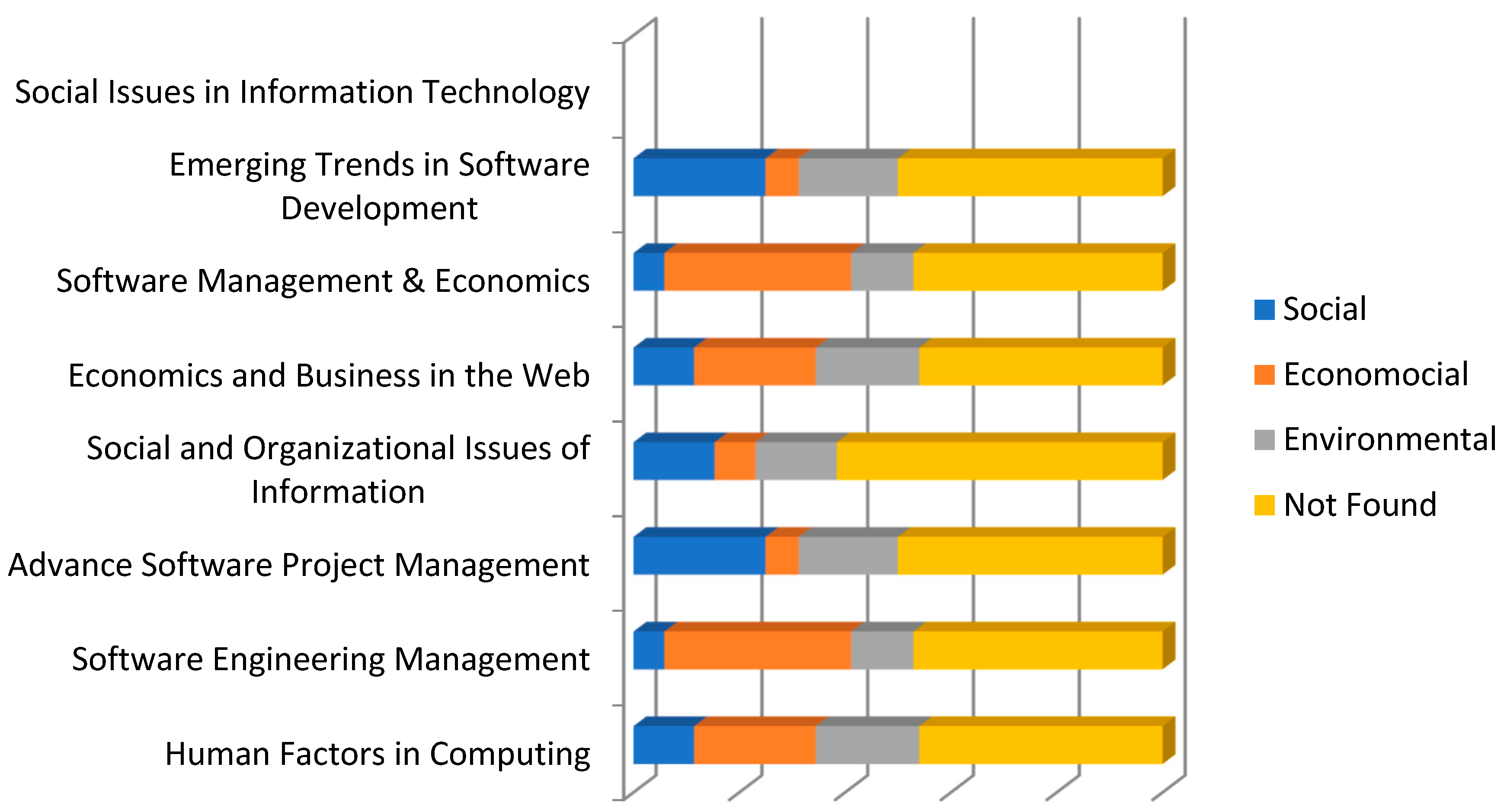
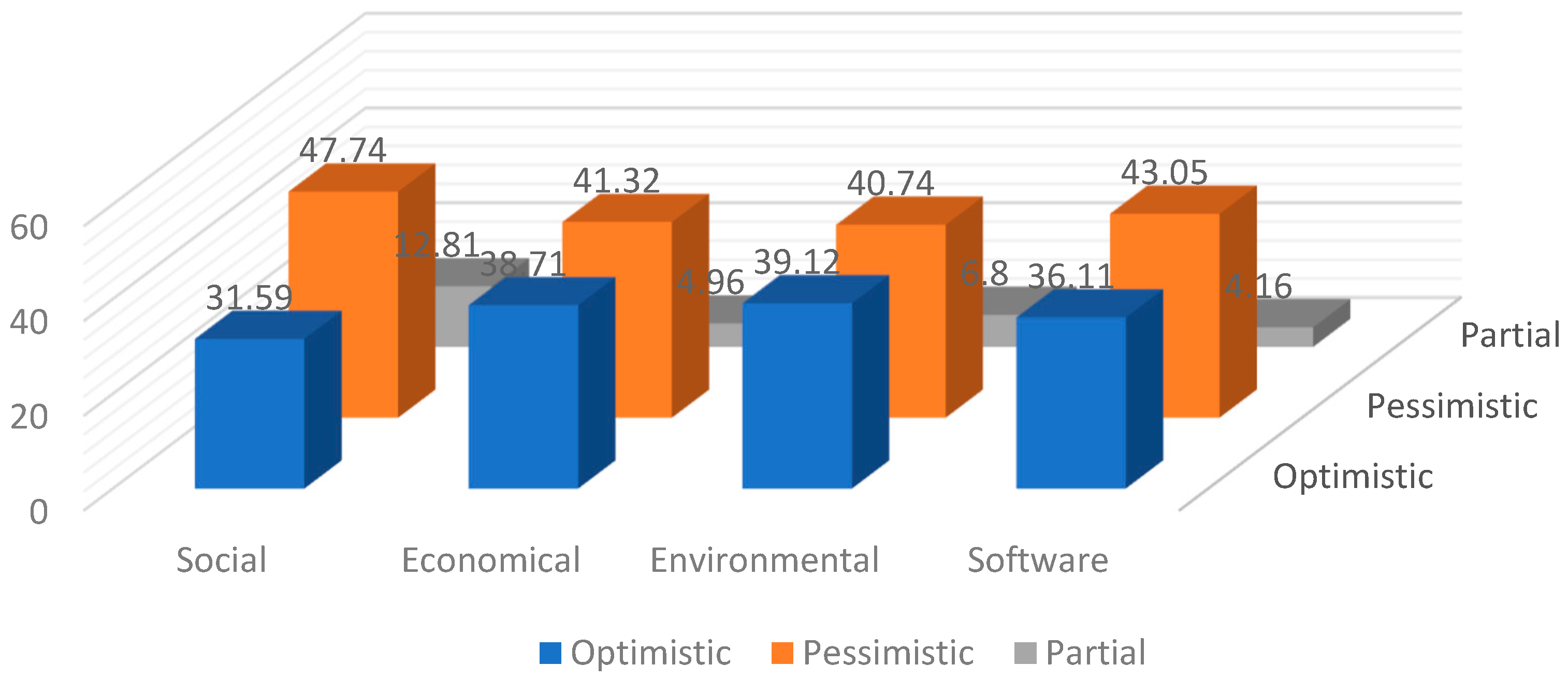
| Sr.# | Name of Selected Universities | Region (Provinces) |
|---|---|---|
| 1 | University of Karachi | Sindh |
| 2 | NED University of Engineering and Technology | Sindh |
| 3 | University of Engineering and Technology (UET) | Khyber Pakhtunkhwa (KPK) |
| 4 | University of Peshawar | Khyber Pakhtunkhwa (KPK) |
| 5 | University of Malakand, Chakdara | Khyber Pakhtunkhwa (KPK) |
| Demographic Detail | n (%) | |
|---|---|---|
| Age | 20–25 y | 76 (52.77) |
| 25–30 y | 68 (47.22) | |
| Gender | Male | 93 (64.58) |
| Female | 51 (35.41) | |
| Degree/Course | Computer Science | 48 (33.33) |
| IT | 43 (29.86) | |
| Software Engineering | 53 (36.80) | |
| Level | Postgraduate | 68 (47.22) |
| Undergraduate | 76 (52.77) | |
| Working Status | Not-Employed | 91 (63.19) |
| Employed | 53 (36.80) | |
| University/DAI Name | Faculty | Department | Program Offered | Courses Content with Perspective of Sustainability in Technology Development | Analysis of Courses |
|---|---|---|---|---|---|
| Air University, Islamabad | Faculty of basic and applied sciences | Department of Computer Science and Engineering | Undergraduate program (Bachelor of Computer Science) | Professional Practices in IT | Historical, social, and economic context of Computing (software engineering, Computer Science, Information Technology) |
| Allama Iqbal Open University, Islamabad (AIOU) | Faculty of Sciences | Department of Computer Science | Post Graduate Diploma in Computer Science (PGD(CS)) Bachelor of Science (Computer Science) MS Computer Science | Software House practices (offered in the Bachelor of science degree) | Historical, social, and economic context of Computing (software engineering, Computer Science, Information Technology) |
| Bahria University, Islamabad | Department of computer science ----------- Department of computer and software | BS computer science BS information technology MS computer science PhD. Computer science --------- BS Computer engineering BS software engineering PhD in software engineering | Professional Practices (offered in BS computer science) | Historical, social, and economic context of Computing (software engineering, Computer Science, Information Technology) | |
| COMSATS Institute of Information Technology, Islamabad | Faculty of information and technology | Department of computer science | Bachelor of computer science (BSCS) Bachelor of Software Engineering (BSSE) MSCS MSIT MSSE | Professional practice (BSSE) Software Project Management (BSSE) Advanced software project management (MSCS and MSSE) | The professional practice course is specifically designed to critically analyze and evaluate the consequences of computing on individuals, organizations, and society. This course will help to examine the Information Technology professionalism, ethical decision making, and codes of ethics. With the help of these students will analyze situations of computer use and technology and policy proposals, identifying the salient issues and evaluating the reasoning about them. Software Project Management course covers management techniques to plan, execute, and control software development projects. Upon completion, participants should be able to estimate and plan effectively monitoring the process and perform a project risk assessment for a software development project. They will also study how software development is integrated with other business activities and how social and environmental factors impact development. |
| Dawood University of Eng. & Technology, Karachi | Faculty of the computer system and engineering | Department of computer system engineering | BE(CS) | NIL | NIL |
| Federal Urdu University of Arts, Sciences & Technology, Islamabad | Faculty of science and technology | Department of computer science | The undergraduate and postgraduate program | NIL | NIL |
| International Islamic University, Islamabad | Faculty of Basic and Applied Sciences | Department of computer science and software engineering | BS Computer Science, BS Software Engineering MCS Computer Science, MS Computer Science MS Software Engineering PhD in Computer Science PhD in Software Engineering | NIL ------------------- Software engineering economics, software project management (BSSE) -------------- Software engineering management, Human factors in computing (MSSE) | |
| National University of Modern Languages, Islamabad (NUML) | Faculty of engineering and computer science | Department of software engineering, Department of computer science | BSSE ------------------- BSCS, MSCS | Software project management --------------- Software project management (BSCS) | |
| National University of Sciences & Technology, Rawalpindi/Islamabad (NUST) | School of electrical engineering and computer science (SEECS) | Department of computing | BESE BSCS MS and PhD in Computer Science, MS and PhD in IT, | Software engineering economics, software project management (BESE) ------------- Software Project Management, Software Engineering Economics (BSCS) NIL ------------------ NIL | |
| Pakistan Institute of Engineering & Applied Sciences, Islamabad (PIEAS) | Faculty of Computer and information science | Department of Computer science | BS in Computer and Information Science M. Phil in Computer Science PhD in Computer Science | NIL | |
| Quaid-i-Azam University, Islamabad | Faculty of natural science | Computer science | PhD in Computer Science MPhil in Computer Science MS in Information Science & Technology MSc in Computer Science BS in Computer Science | NIL ----------------- Social and Organizational Issues of Information, Economics and Business in the Web (M.Phil CS) --------------------------- Software Management & Economics (MSIS and Tech) Emerging Trends in Software Development, Social Issues in Information Technology, software project management (MS CS) -------------- NIL | |
| Virtual University of Pakistan, Lahore | Faculty of computer science and information technology | Department of computer science and information technology | BS in Computer Science BS in Information Technology BS in Software Engineering Master in Computer Science Master in IT MS in Computer Science PhD in CS | NIL ------------- NIL -------------- Software project management ----------- NIL ----------- Software project management --------------- NIL ----------------- NIL |
| Sr. # | Sustainability Dimensions | Optimistic % | Pessimistic % | Impartial % |
|---|---|---|---|---|
| 1 | Environmental Sustainability | 31.59 | 47.74 | 20.31 |
| 2 | Social Sustainability | 38.71 | 41.31 | 19.96 |
| 3 | Economic Sustainability | 39.1 | 40.74 | 20.1 |
| 4 | General Understanding of Sustainability | 36.1 | 43.05 | 20.83 |
© 2019 by the authors. Licensee MDPI, Basel, Switzerland. This article is an open access article distributed under the terms and conditions of the Creative Commons Attribution (CC BY) license (http://creativecommons.org/licenses/by/4.0/).
Share and Cite
Malik, M.N.; Khan, H.H.; Chofreh, A.G.; Goni, F.A.; Klemeš, J.J.; Alotaibi, Y. Investigating Students’ Sustainability Awareness and the Curriculum of Technology Education in Pakistan. Sustainability 2019, 11, 2651. https://doi.org/10.3390/su11092651
Malik MN, Khan HH, Chofreh AG, Goni FA, Klemeš JJ, Alotaibi Y. Investigating Students’ Sustainability Awareness and the Curriculum of Technology Education in Pakistan. Sustainability. 2019; 11(9):2651. https://doi.org/10.3390/su11092651
Chicago/Turabian StyleMalik, Muhammad Noman, Huma Hayat Khan, Abdoulmohammad Gholamzadeh Chofreh, Feybi Ariani Goni, Jiří Jaromír Klemeš, and Youseef Alotaibi. 2019. "Investigating Students’ Sustainability Awareness and the Curriculum of Technology Education in Pakistan" Sustainability 11, no. 9: 2651. https://doi.org/10.3390/su11092651
APA StyleMalik, M. N., Khan, H. H., Chofreh, A. G., Goni, F. A., Klemeš, J. J., & Alotaibi, Y. (2019). Investigating Students’ Sustainability Awareness and the Curriculum of Technology Education in Pakistan. Sustainability, 11(9), 2651. https://doi.org/10.3390/su11092651







